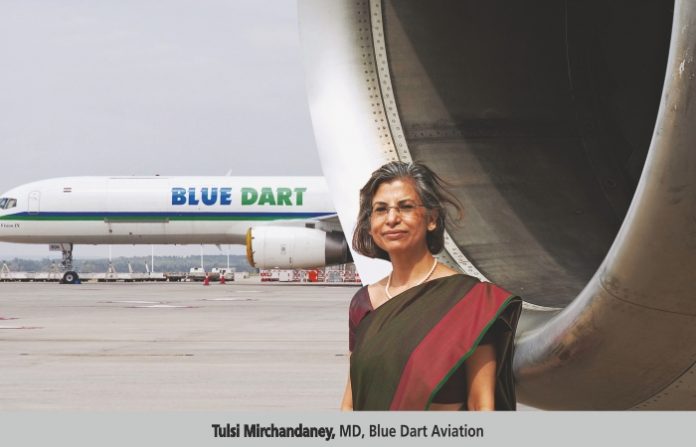Blue Dart Aviation has transported tonnes of cargo carrying essential supplies since the nationwide lock-down began. There have been many disasters in the past where air cargo has played a major role. Tulsi Mirchandaney, MD, Blue Dart Aviation talks about the stellar role played by the air cargo industry to make ends meet.
Kalpana Lohumi
What has been the most difficult challenge for Blue Dart since the outbreak of the pandemic?
Blue Dart has been functional through the pandemic, with our teams working round the clock to ensure essential supply chain continuity. We took an early decision to sustain our operations and prepared for the eventuality of domestic and probable international charter operations, even before the pandemic-enforced lockdown was imposed.
A number of challenges emerged as we moved through various phases of the lockdown. Initially, road transport came to a halt with additional restrictions on interstate travel. Blue Dart’s market differentiator, our Boeing 757-200 freighters, ensured that the essential lifeline remained undisrupted. The mass migration from cities and towns to villages had a countrywide impact. However, our dedicated and committed Blue Darters stepped up, as they have always done in the past, to navigate the new crisis and find ways amidst the stringent directives to keep our operations running and our planes in the air.
Air cargo has played a stellar role during the pandemic. Under extremely difficult conditions, when most were confined to the safety of their homes, this segment of aviation worked every single day through the lockdown to provide the only accessible logistics network across the country and overseas.
However, the air cargo segment is still hurting. High fixed costs remain unchanged, the depreciation of the rupee impacts our lease and maintenance cost, and, the commodity mix has changed. While certain segments like e-commerce and pharma have grown, we are yet to witness other industries get back to their earlier levels. The ATF cost is now back to the pre-COVID levels and is the biggest hit. ATF is a well-worn subject that is continuously brought up because it is a core cost component. For a cargo airline, it accounts for close to 40 per cent of direct operating cost. Unlike passenger airlines where excess belly capacity is used for incremental revenues, space on freighters is the mainstay of our revenue.
What do you expect would emerge as the key issues affecting the freight forwarding and air cargo business, after the outbreak disappears? What will be your immediate priorities in the post-COVID-19 scenario?
Crises are part of the risks of an operating environment and would continue to plague us in some form. Management and mitigation of the risks, especially an unprecedented one as in the recent past, add to the body of work that goes into our preparedness for the future. I believe the recent pandemic has gained air cargo its rightful place as an important lifeline in the face of disasters. Though there have been many disasters in the past where air cargo has played a major role, but none have sustained over such a prolonged period. Technology has also been our friend that has enabled businesses to remain connected and facilitated consumption. E-commerce is here to stay.
Both the above factors herald an opportunity for our industry, which we should approach with a mission-critical zeal. When the economy revives, we should have the capacity and differentiated service quality to meet the growing demand.
How would you evaluate the current state of the air cargo sector in India?
The prime enablers for air cargo have been and would continue to be a reasonable cost environment and support infrastructure. Too many startup cargo airlines have fallen by the wayside within a short time of launch, testimony to the difficult operating environment. We need our policymakers and stakeholders to envision the vast opportunities that lie ahead and make bold decisions so that we are not distracted by our daily battle for basics.















